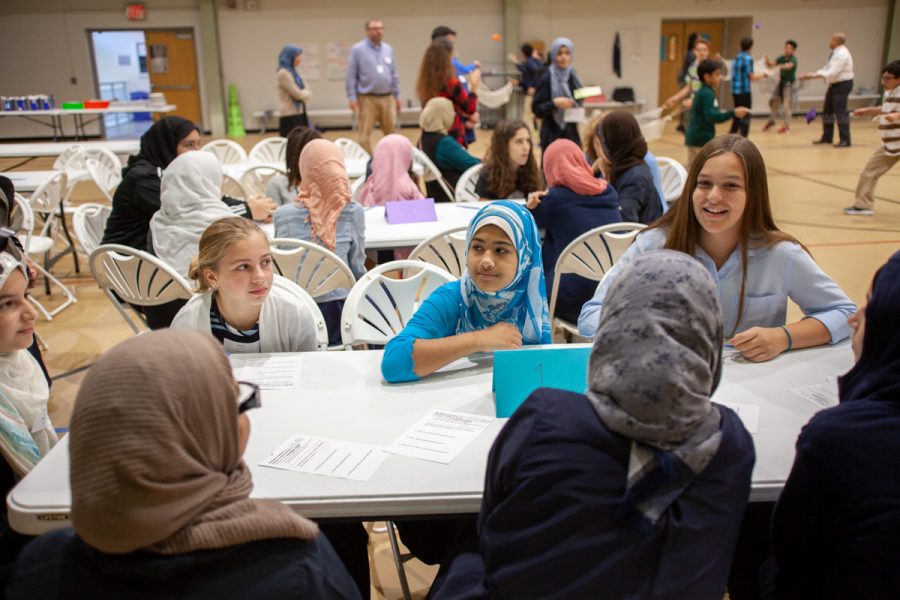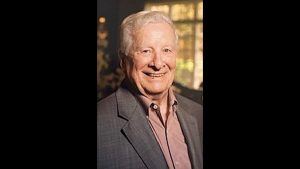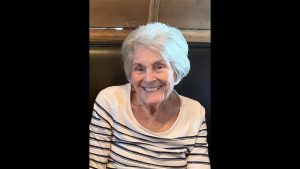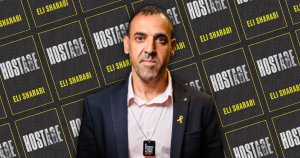Program connects St. Louis students from Jewish and Muslim day schools
Published April 4, 2019
Picture four middle schoolers playing a game of catch-and-release. Divided into pairs, each twosome holds onto either end of a net and tosses a beanbag back and forth, trying to land it in the other pair’s net.
The objective isn’t for one pair to beat the other, but for the foursome to work together to see how many times they can get the beanbag into the other’s net within a minute.
Now picture that each pair in this group consists of a Jewish middle-school student and a Muslim middle-school student.
ADVERTISEMENT
Welcome to Operation Cooperation Middle School (OCMS), a new initiative that brings together middle-school students from Saul Mirowitz Jewish Community School and Al-Salam (Muslim) Day School in Ballwin four times during the 2018-2019 school year, with each school visiting the other twice. The hope is to have these students work collaboratively and productively as they learn about one another, without compromising any of the fundamental faith values essential to their respective schools and their families.
“We want the world to be a better place,” said Cheryl Maayan, “and we know it will be if we raise this generation to be compassionate, thoughtful, knowledgeable, kind and respectful of each other and each other’s differences.”
Added Mohamed Ahmed: “Our main goal is to expose our students to people their own age they would likely not encounter until college or the workforce.”
Maayan is head of school at Mirowitz and Ahmed is the head of school at Al-Salam. The two, along with some teachers and students at each school, were inspired to create the middle-school program based on the success they were already having with an exchange program for third graders. That program — Operation Cooperation Third Grade — began in 2002, with Solomon Schechter Day School, Al-Salam and two St. Louis-area Christian schools. It is still going on.
ADVERTISEMENT
Maayan says while the third-grade program is age appropriate and “a great start,” Operation Cooperation Middle School goes much deeper. It’s a narrower program, with middle schoolers from only the Muslim and Jewish schools, which together totals about 100 students.
“The goal of the third-grade program is for students from the four schools to meet one another and do team building exercises. They never talk about their differences,” said Maayan. “With the Christian schools involved, the Jewish and Muslim students become the minority. By focusing on just our two schools (Mirowitz and Al-Salam), we felt the kids could learn more deeply about one another and their different faiths.”
The heads of the schools agreed in advance that the program would not include any discussion about the Middle East conflict.
“We felt that would be a barrier for parents and we don’t think (the students) are equipped to have those conversations because they don’t have relationships with one another yet,” said Maayan.
***
To help foster those relationships and measure their impact with before-and-after surveys, the two schools engaged EnTeam, which has been facilitating the third-grade program since its inception. EnTeam is an educational nonprofit that uses various learning strategies to encourage collaboration and working together among students.
“We help kids understand that they can be good neighbors and solve problems without agreeing on everything,” said Ted Wohlfarth, EnTeam executive director. “We try to set up situations where kids learn to win by working with the other side. We all have conflicting goals and complementary goals. If we measure progress on complementary goals, we have a win-win contest.”
Wohlfarth points to the catch-and-release game that the Jewish and Muslim middle schoolers played. In order to launch the beanbag and catch it successfully, the students need to trust each other and work in concert.
“Let’s say the four students tossed and caught the beanbag 17 times within a minute,” Wohlfarth said. “The next question is: How can the four of you improve your performance? It gets hard to improve once you reach a certain level of competence, so you have to come up with creative strategies that challenge you to work together. We all lose if we can’t improve and we all win if we can.”
The first two sessions of OCMS mirrored each other with team-building activities and a prayer service, capped by a snack of fruit and cookies. Students at Mirowitz observed Al-Salam students praying in their mosque; a couple of months later, Al-Salam students watched their Mirowitz counterparts during their morning prayer service.
“I wasn’t too surprised to see them take off their shoes before they entered the mosque to pray but I didn’t know the girls and boys would be separate,” said Caleb Arnow, a sixth grader at Mirowitz. “I noticed that there is a lot of movement in their prayer service. In Judaism, there is standing, sitting and bowing the head but they bow to the ground and stand up and bow again to the ground. It’s all very physical.
“The whole experience has made me really curious,” Caleb added. “I want to know if their school is one-of-a-kind or if all Muslim schools are like that.”
***
In February, at the third exchange, Al-Salam students created five, 15-minute mini-lessons, each one aimed at teaching Mirowitz students about one of the five pillars of Islam: shahadah (declaration of faith), meaning there is no God but Allah and Muhammed is his prophet; salah, praying five times a day toward Mecca; sawm or fasting during the month of Ramadan; zakat, an obligation to give to charity; and hajj, a pilgrimage to Mecca that all Muslims should make at least once in their lives.
After the Al-Salam students gave their presentations, the Mirowitz youngsters flooded them with questions.
“Is there a certain amount of money you have to give to charity?” asked one, likening the practice to the Jewish tradition of tzedakah. (Answer: About 2.5 percent of one’s total wealth.)
“Is there a certain time of the year for Hajj?” asked another. (Answer: The first 10 days of the 12th and final month in the Islamic calendar. Some Mirowitz students noted that Judaism and Islam both observe a lunar calendar.)
“How much does Hajj cost?” asked still another. (Answer: between $8,000 and $20,000 per person.)
“I feel (OCMS) has really opened my eyes to see the similarities between us,” said Zahava Kiernan, a sixth-grader at Mirowitz. “Their Quran and what it means to them is not unlike our Torah and what it means to us. Their religion is important to them, just like ours is important to us.
“The girls wear hijabs to cover their heads. In Judaism, the boys wear kippahs to cover theirs. Married Orthodox women don’t show their hair and dress modestly just like Muslim women do. They have prayers for everything and pray multiple times a day just like we do in Judaism.”
***
Next week will be Mirowitz’s turn to show Al-Salam students what Judaism is about — in roughly two hours time. Zahava says she and her classmates are preparing a Judaism 101 class.
“We will talk about our values, tzedakah, the Torah, having a bar or bat mitzvah, what it’s like to keep kosher and why,” she said. “We’ll explain the diversity of Judaism — Orthodox, Conservative and Reform — and talk about our holidays.”
Haya Ahmed, an eighth-grader at Al-Salam, is looking forward to the experience. She says even though there is a Jewish teacher at her school, she wants “to learn more about the Jewish religion because she doesn’t know much about the Jewish people other than they believe in Moses.”
“I really didn’t have any pre-conceived ideas going into this,” she added. “So far, everyone I met has been nice and welcoming.”
Janet Curry, who attends Central Reform Congregation and teaches social studies at Al-Salam, isn’t surprised that her students are so engaged. “There is a kindness and gentleness of spirit among these students that takes instantly to learning seriously and is binding in their respect for one another,” she said. “It’s really unusual to see such depth in adolescents.”
The same can be said of the Mirowitz students, who also seem genuinely interested in knowing more about their new Muslim friends. A few are even playing a popular video game together.
“When we were split into small groups of Jewish and Muslim students, I went home and friended (the Muslim students) on Facebook,” said Nadav Fredman, an eighth grader at Mirowitz. “We started playing Fortnite a few times a week.”
Mirowitz Athletic Director and middle school social studies teacher Gary Lerner took the exchange a few steps further last week by organizing a basketball game between the Al-Salam and Mirowitz boys. A similar soccer match is set for this week.
“It seemed like a natural outgrowth of the relationship we are building between our two schools,” explained Lerner, whose daughter, an eighth grader at Mirowitz, now has friendships with some of the girls she met at Al-Salam. “It’s a way for sportsmanship to enhance the respectful connection that the students are building.”
When asked which school won the basketball game, Al-Salam Head of School Ahmed laughed and said, “What does it matter? With this program, we all win.”
















